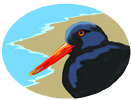
The Blue Grouse is the common resident grouse of our mountains. In early spring, while there is still snow on the ground you can hear their courtship hooting.
The Blue is one of the largest grouse at 17-22”. They are mottled brownish gray with a broad gray band at the tip of their tail. Their short legs are feathered. The males have a blue gray cap and an orange bare spot or “comb” over the eye. They have yellow patches on their throat surrounded by white feathers, which inflate for courtship.
The Blue Grouse are unique in their vertical migrations on mountain slopes. In spring they move down from the high coniferous woods to the upper edge of the deciduous forest where courtship is carried out. The male calls from a stump or tree perch and inflates his yellow air sacs to amplify his hooting and growling. Most of the male’s song is so low the human ear cannot hear it. Courtship also involves elaborate displays with short fluttering flights off the ground and strutting with air sacs inflated and tail fanned, much like a turkey gobbler.
After mating the male return upslope to the conifers and alpine meadows. The female stays below and raises 7-10 young. Their diet is mainly insects to start and then expands with berries, leaves, seeds and flowers. The winter diet is mainly conifer needles and buds.
By September all return to higher elevations to winter in the branches of conifers or burrows in the snow. They even grow their own snowshoe with a fringe of scales around their toes.
For the Mendocino Coast Audubon I’m Pam Huntley wishing you happy birding.
Blue Grouse photo courtesy Tom Bouchert
